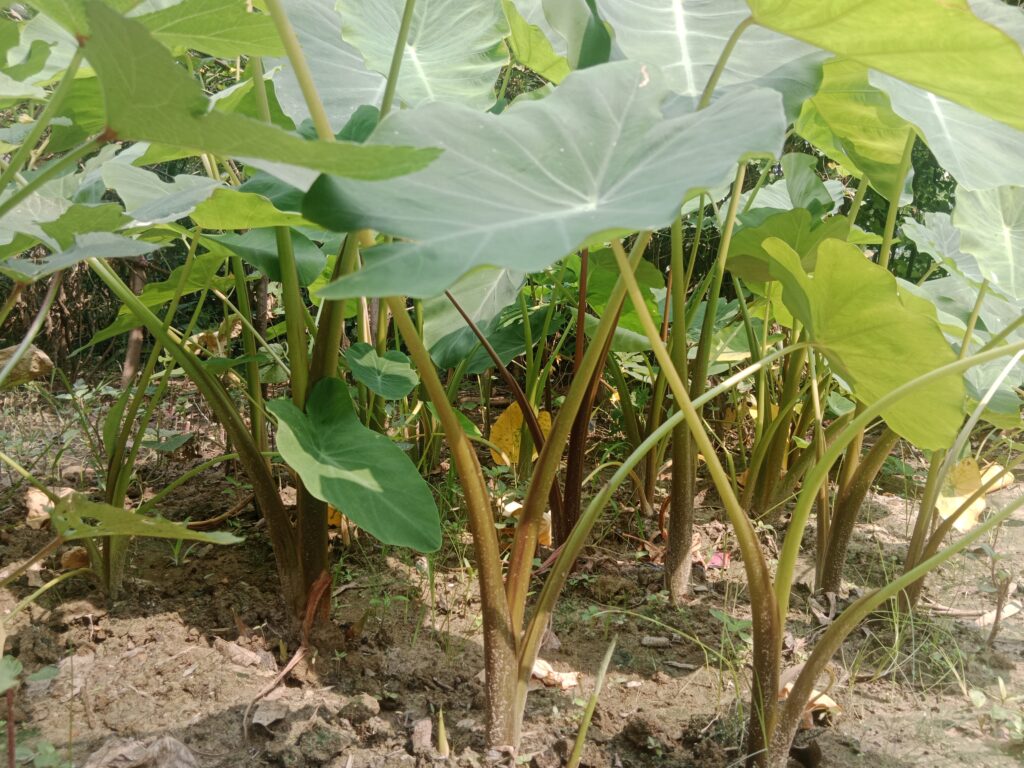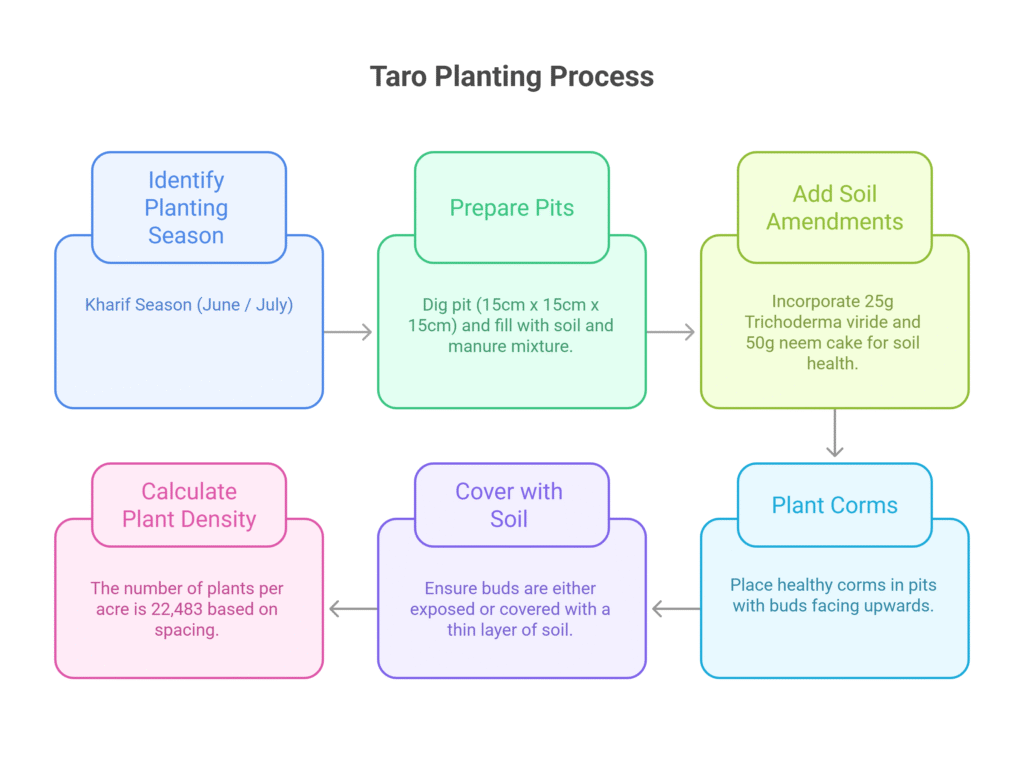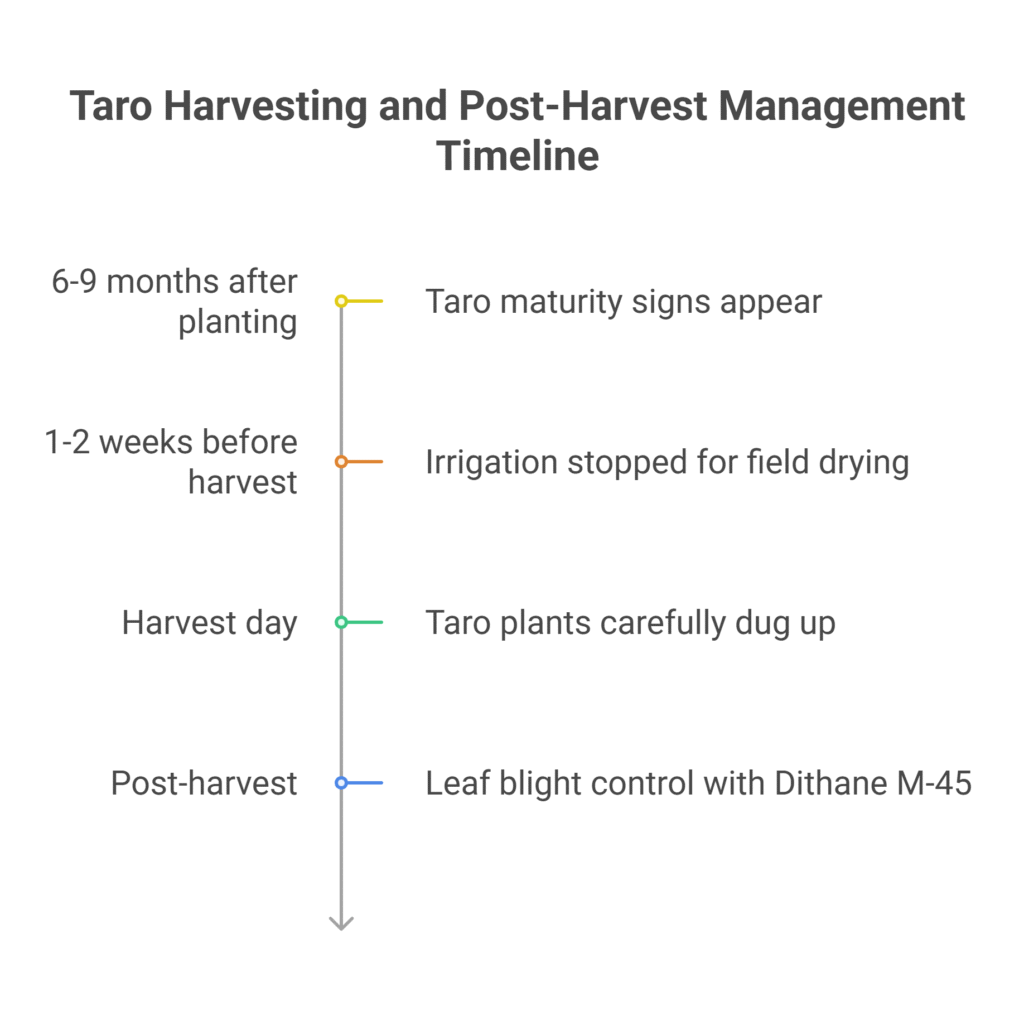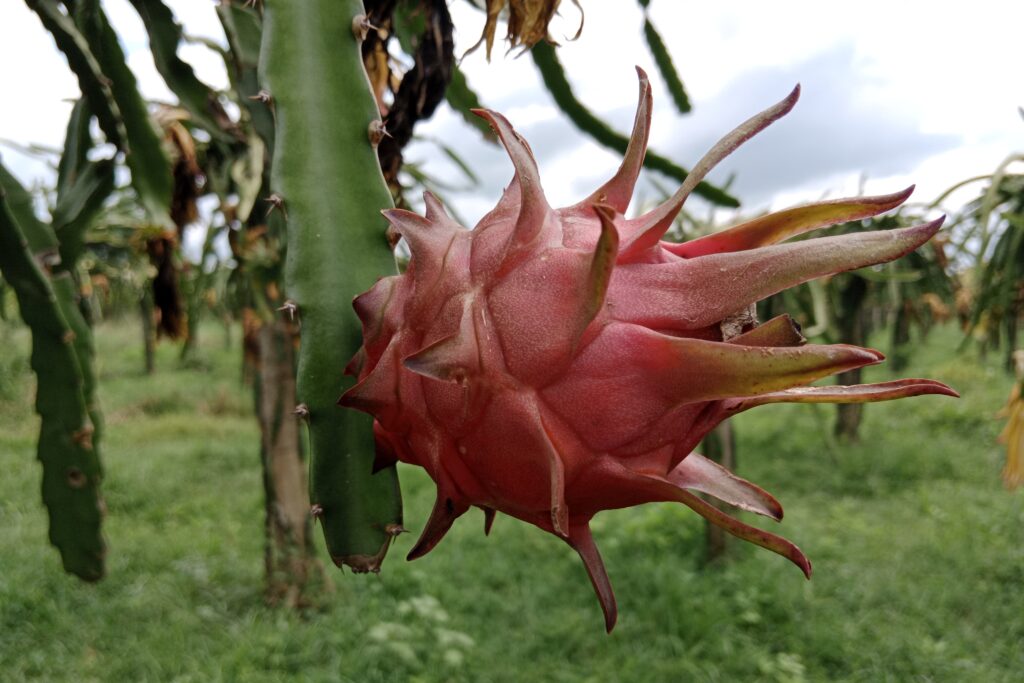Arum Arvi Farming
Arum arvi farming profit per acre demonstrates the strong economic potential of cultivating this root crop under proper management practices. A detailed profit analysis shows that taro (Arum arvi) farming can generate a total income of NRs 180,000 per acre against a relatively low investment of NRs 36,000, resulting in a substantial net profit of NRs 144,000. This equates to a profit of NRs 12 per kilogram of taro produced, making it a cost-effective and rewarding venture for farmers. With a remarkable return on investment (ROI) of 400%, where every NRs 1 invested returns NRs 5 (including NRs 4 profit), Arum arvi farming proves to be a highly profitable enterprise under favorable conditions.

Land Preparation
Land preparation for taro begins with 1-2 deep plowings (20-25 cm depth) to loosen the soil and improve aeration. 2-3 cross harrowings follow this to break down soil clods, level the field, ensure uniform water distribution, and prevent waterlogging. The aim is to achieve a fine, friable tilth, which is essential for optimal corm development and facilitates easier planting and harvesting; additionally, in areas prone to water stagnation, raised beds or ridges should be formed for planting.
Soil Type
Rich in organic content, taro thrives in sandy loam or deep, fertile, well-drained loamy soils that promote strong root and corm development. Even though the plant may tolerate a wider range of soil types, such as clay loams, it is imperative to stay away from heavy, poorly drained clay soils. Such circumstances make corm rot far more likely. Although it can tolerate some weakly alkaline conditions, taro thrives on slightly acidic soils with a pH range of 5.5 to 7.0. In contrast to its favored range of slightly acidic soils, it typically grows less vigorously on neutral or highly alkaline soils.
Climatic Requirements
| Climatic Factor | Requirement | Notes |
| Temperature | Warm and humid conditions are ideal. Optimal: 25°C to 35°C. | Growth is severely retarded below 10°C; frost is fatal. |
| Rainfall | Abundant moisture required (~1500-2000 mm annually). | Consistent soil moisture is critical. Avoid water stagnation. |
| Humidity | High relative humidity is beneficial (80-90%). | Supports healthy growth in warm conditions. |
| Light | Grows best in partial shade to full sun. | Intense, scorching sun can damage leaves (varies by variety). |
Major Cultivars
Taro cultivation features numerous local and improved varieties, exhibiting significant variation in characteristics such as corm shape, size, color (including white, pink, and purple), taste, maturity time, and leaf traits. In India, commonly cultivated varieties include Saraswati, Narendra Arvi, Muktakeshi, Satamukhi, Suruchi, PLR-1, Sree Kiran, and Sree Rashmi, alongside many region-specific landraces. When selecting a cultivar, key considerations should be local adaptability, market preference (whether primarily for corm or leaf production), inherent disease resistance, and the desired maturity period.
Seed Rate
For planting taro, a seed rate of 300 to 400 kilograms of tubers per acre is recommended. Before planting, the tubers should undergo seed treatment by being dipped in a 2% solution of Bavistin for 30 minutes; this process effectively protects them from soil-borne diseases.
Planting
a) Planting Season
Taro is primarily planted during the Kharif season, which usually begins in June or July when the monsoon arrives. In areas with guaranteed irrigation, it can also be planted in the spring (February–March) or early summer (April–May). Depending on the local climate, especially the timing of monsoon rains and regional temperature patterns, the precise planting period may change.

b) Spacing
Taro is commonly planted at a spacing of 60 cm between rows and 30 cm between plants.
c) Pit Preparation
For taro cultivation, prepare pits measuring 15 cm × 15 cm × 15 cm at the recommended spacing, and fill each pit with a mixture of topsoil and 3–5 kg of well-decomposed farmyard manure (FYM) or compost. Additionally, enrich the mixture with 25 g of Trichoderma viride and 50 g of neem cake per pit to enhance soil health and protect against soil-borne pathogens before planting.
d) Planting Method
For planting taro, use healthy, disease-free small whole corms or sections of larger corms known as “setts,” each containing at least one viable bud or “eye.” Plant the corms or setts in the prepared pits with the bud facing upwards and cover them with the soil mixture so that the bud is either just exposed or covered with about 2–5 cm of soil, ensuring proper establishment and sprouting.
e) Number of Plants per Acre
With a spacing of 60 cm × 30 cm, approximately 22,483 taro plants can be accommodated per acre, ensuring optimal plant population for healthy growth and maximum yield.
Intercropping
Intercropping in taro cultivation is feasible during the initial 2–3 months before the canopy closes, allowing for the cultivation of short-duration vegetables such as radish, spinach, coriander, and onion. It is advisable to avoid tall or heavy-feeding crops that compete aggressively with taro for nutrients and light. This practice helps maximize land use efficiency and offers an opportunity for early income generation.
Irrigation
Taro requires consistent soil moisture throughout its growth period, particularly during corm development, as drought stress can significantly reduce yield. Irrigation should be applied immediately after planting, followed by watering every 7–10 days during summer or dry periods and every 12–15 days in cooler or wetter conditions, with adjustments based on soil type and weather. Furrow irrigation is commonly used, while drip irrigation offers greater efficiency and water conservation. However, proper drainage is crucial, as waterlogging for more than 24–48 hours can lead to root and corm rot diseases.
Fertilizer and Manure
| Factor | Recommendation (Per Acre) | Application Timing/Method |
| Organic Matter | 10-15 tonnes of well-decomposed FYM or compost | Incorporated uniformly during land preparation |
| Inorganic Fertilizers | Adjust based on the soil test | |
| ‣ Nitrogen (N) | 60-80 kg | Split: • 1/3 as basal dose • 1/3 at 45 Days After Planting (DAP) • 1/3 at 90 DAP |
| ‣ Phosphorus (P₂O₅) | 50-60 kg | Applied fully as a basal dose at planting |
| ‣ Potassium (K₂O) | 80-100 kg | Applied fully as a basal dose or split similarly to nitrogen |
Weed Control
Effective weed control in taro is crucial during the first 2-3 months after planting, before canopy closure occurs, and can be managed through a combination of methods: primarily timely mechanical removal via 2-3 hand weedings or hoeings (typically at 25-30, 45-50, and 60-65 days after planting), careful application of pre-emergence herbicides like Pendimethalin (400g-500g active ingredient per acre) after planting but before weed emergence (following label instructions strictly, as post-emergence options are limited), and the use of organic mulch (such as paddy straw or dry leaves) or black plastic mulch around plants to suppress weed growth and conserve soil moisture.
Flowering and Fruit Management
Taro plants may occasionally produce a spathe and spadix inflorescence, similar to that of an arum lily. However, this is not common across all varieties or growing conditions and tends to occur more frequently in certain cultivars or during cooler months. Flowering is generally considered undesirable in taro cultivation, as it diverts energy away from corm development; therefore, any flower stalks that appear should be removed promptly. Fruit formation (berries) is rare under cultivation and holds no practical use.
Pest and Disease Management
Common Pests
a) Aphids
Aphids are common pests in taro cultivation that damage the crop by sucking sap from tender plant parts, leading to curling, yellowing, and stunted growth. In addition to direct feeding damage, they are known vectors of several plant viruses, which can severely impact crop health and yield. Effective control measures include the application of systemic insecticides such as Imidacloprid or Dimethoate at 1ml / litre water, which help reduce aphid populations. Additionally, promoting natural enemies like ladybird beetles, lacewings, and parasitic wasps can offer sustainable biological control to keep aphid infestations in check.
b) Spider Mites
Spider mites are microscopic pests that consume taro leaves, resulting in distinctive stippling, yellowing, and occasionally webbing that can weaken the plant and decrease photosynthesis. To manage infestations and preserve leaf health, effective control involves using miticides like wettable sulfur, abamectin, or dicofol.
c) Corn Borers/Weevils
Corn borers or weevils are destructive pests whose larvae tunnel into taro corms, causing internal damage that reduces yield and market quality. Effective control involves using pest-free planting material, practicing crop rotation to break the pest cycle, and applying Carbofuran to the soil at planting, though its use must follow regulatory guidelines. Additionally, drenching the soil with Profenofos at 2ml / litre water can help manage existing infestations.
d) Leaf Feeders (Caterpillars/Beetles)
Leaf feeders such as caterpillars and beetles chew on taro leaves, reducing the plant’s photosynthetic capacity and overall vigor. To manage these pests effectively, insecticides like Malathion and Quinalphos can be used, along with neem-based botanical sprays for eco-friendly control.
Common Diseases
a). Phytophthora Leaf Blight
Leaf blight, a disease prevalent during the rainy season when temperatures range between 20-22°C at night and 25-28°C during the day, manifests as water-soaked circular lesions on leaves that subsequently turn yellow or dark purple upon drying. To control this disease, apply Dithane M-45 at a rate of 400-500 grams per acre diluted in 100-150 liters of water, repeating the spray application at 7 to 14-day intervals until the infection is managed.
b) Pythium Corm/Root Rot
Pythium rot, also known as corm rot, is a fungal disease in taro characterized by stunted growth, shortened leaf stalks, curled and crinkled leaf blades, and yellowish, spotted leaves. To manage this disease, apply Captan 50WP at a rate of 44–45 kg per acre for effective control.
c) Sclerotium Rolfsii (Stem Rot/Collar Rot)
Sclerotium rolfsii, commonly known as stem rot or collar rot, appears as white fungal growth at the base of the taro plant, often leading to wilting and plant collapse. Effective control measures include deep plowing to expose and destroy fungal structures, soil drenching with Carbendazim to suppress infection, and avoiding deep planting to reduce the risk of disease development.
d) Dasheen Mosaic Virus
When dasheen mosaic virus strikes taro plants, it results in stunted growth and a light green mosaic pattern on the leaves, which can drastically lower crop vigor and production. Using planting material free of viruses, managing aphid vectors that spread the virus, and quickly eliminating diseased plants to stop their spread are all components of effective management.
Harvesting
a) Maturity Signs
Taro is ready for harvest when the lower leaves begin to yellow and wither, typically 6–9 months after planting, depending on the variety and growing season. Irrigation should be stopped 1–2 weeks before harvesting to allow the field to dry slightly. Plants are then carefully dug up using a spade or fork from a safe distance to avoid damaging the corms, and the entire plant is lifted and excess soil shaken off.

b) Post-Harvest
Leaf blight, a disease prevalent during the rainy season when temperatures range between 20-22°C at night and 25-28°C during the day, manifests as water-soaked circular lesions on leaves that subsequently turn yellow or dark purple upon drying. To control this disease, apply Dithane M-45 at a rate of 400-500 grams per acre diluted in 100-150 liters of water, repeating the spray application at 7 to 14-day intervals until the infection is managed.
c) Yield
Taro yield varies significantly depending on the variety and management practices, with corm yields typically ranging from 8 to 15 tonnes per acre and reaching over 20 tonnes per acre with high-yielding varieties under optimal conditions. Additionally, taro leaves can produce 5 to 10 tonnes per acre when harvested multiple times during the growing season.
Cost of Investment in Per Acre Arum Arvi Farming
| S.N. | Categories | Cost (NRs) |
| 1 | Land Preparation (Plowing) | 10,000 |
| 2 | Seed | 3,000 |
| 3 | Seed Planting | 2,000 |
| 4 | Fertilizers and Manure | 4,000 |
| 5 | Irrigation | 5,000 |
| 6 | Weed Control (Pre & Post-Emergence) | 1,000 |
| 7 | Pest & Disease Control | 3,000 |
| 8 | Harvesting | 5,000 |
| 9 | Miscellaneous Costs | 3,000 |
| Total Cost | 36,000 |
Income from Arum Arvi Farming Per Acre
| Particulars | Estimated Yield (kg) | Market Price (NRs/kg) | Total Income (NRs) |
| Arum Arvi (Taro) | 12,000 | 15 | 180,000 |
Analysis of Arum Arvi Farming Profit Per Acre
The profit analysis reveals that taro farming yields a total income of NRs 180,000 per acre with a total investment of NRs 36,000, resulting in a net profit of NRs 144,000. This translates to a profit of NRs 12 per kg of taro produced. The return on investment (ROI) stands at an impressive 400%, meaning each NRs 1 invested generates NRs 5 in return (including NRs 4 profit). These figures indicate that taro cultivation offers highly lucrative returns under the given assumptions.
Crop Calendar for Arum Arvi (Taro) Farming
(Kharif Season: June-July Planting)
| Period | Stage | Key Activities & Recommendations |
| April-May | Pre-Planting | · Land Prep: 1-2 deep plowings (20-25 cm) + 2-3 cross harrowings; form raised beds in waterlogged areas · Soil Enrichment: Apply 10-15 tonnes/acre FYM/compost + basal fertilizers (50-60 kg P₂O₅, 80-100 kg K₂O, 20-27 kg N) |
| June-July | Planting | · Seed Treatment: Dip 300-400 kg tubers in 2% Bavistin (30 mins) · Pit Prep: Dig 15 cm³ pits at 60 cm × 30 cm spacing (≈22,483 plants/acre); fill with soil-FYM mix + 25g Trichoderma + 50g neem cake · Planting: Place corms/setts (bud up); cover with 2-5 cm of soil · Irrigation: Flood immediately after planting |
| July-Sept | Early Growth | · 1st Weeding (25-30 DAP): Hand weeding or Pendimethalin (400-500g/acre) · Pest Control: Monitor aphids/spider mites; apply neem spray/Imidacloprid (1ml/L) · Fertilizer (45 DAP): Top-dress 20-27 kg N/acre · Intercropping: Plant radish/spinach between rows |
| Oct-Dec | Mid-Stage | · 2nd Weeding (45-50 DAP) · Fertilizer (90 DAP): Apply final 20-27 kg N/acre · Irrigation: Water every 7-10 days (summer) or 12-15 days (winter); use drip/furrow; avoid waterlogging · Disease Control: Spray Dithane M-45 (leaf blight); drench soil with Carbendazim (rot) |
| Jan-Feb | Late Stage | · Flower Removal: Cut stalks to boost corm growth · Moisture Management: Maintain consistent soil moisture · Pre-Harvest Prep: Stop irrigation 1-2 weeks before harvest |
| Mar-May | Harvest | · Timing: 6-9 months post-planting (lower leaves yellow/wither) · Method: Dig carefully; shake off soil · Yield: 8-15 tonnes/acre corms (20+ tonnes for hybrids); 5-10 tonnes/acre leaves · Post-Harvest: Air-dry corms; store in cool shade |


